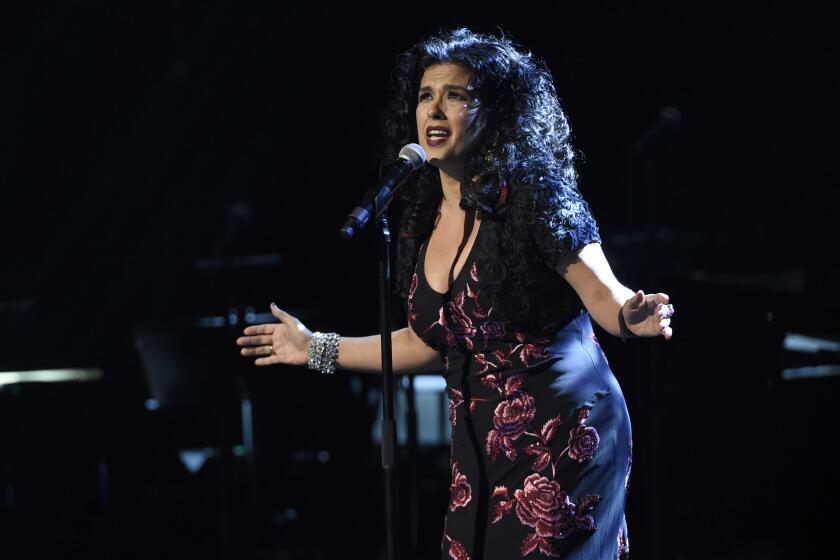‘Grey Gardens’: It’s style, darlings
- Share via
Jacqueline Kennedy Onassis may have been a fashion icon in those perfect sleeveless sheath dresses, oversized sunglasses and triple-strand pearls, but she had nothing on her cousin Edie Bouvier Beale. The improvisational way Beale could tie a scarf -- or a sweater or a skirt -- and fasten it with a brooch at the nape of the neck or the crown of the head is still a revelation.
If she were alive today, she would definitely be a stylist.
It’s no wonder that more than 30 years after the release of Albert and David Maysles’ 1975 documentary “Grey Gardens” about Edie and her mother, Edith Bouvier Beale, we’re still fascinated by the misfit pair who dropped out of society in the 1930s and lived the rest of their days in their decaying East Hampton estate. Even after the gas and telephone service were shut off and credit dried up at the local grocery store, they were proud relics of the upper class, feeding their pet cats and raccoons “luncheons” and diligently assembling the best “costume for the day” from whatever was on hand, even when there was nowhere to go.
The quirky, codependent love story has been a source for countless fashion designers and a subject of many glossy fashion spreads. It has inspired songs, a Broadway musical and now a new film premiering Saturday on HBO.
FOR THE RECORD: This article says “Grey Gardens” director Michael Sucsy wrote the teleplay. In fact, he co-wrote it with Patricia Rozema.
Directed and written by Michael Sucsy and starring Jessica Lange and Drew Barrymore, the film uses the 1975 documentary as a framework for telling the back story of how Big and Little Edie got to the point where all they had was each other.
Whereas the original documentary was filmed over six weeks in 1973, the HBO film also covers the 40 years leading up to it. By exploring Little Edie’s past, and her defiant dream of becoming an actress instead of settling into the trappings of marriage, the film teases out a proto-feminist theme. “The only thing I’m looking for in a man is a dance partner,” she tells Cap Krug, her married suitor.
Big Edie was a bohemian too. In stark contrast to her husband’s three-piece pinstripe suits, in the 1930s she wore all manner of louche loungewear -- velvet dressing gowns, kimonos, palazzo pants, wide-brimmed hats and ethnic-looking necklaces. She defied social convention by hosting lively parties full of singing and dancing, which led to the downfall of her marriage and her isolation at Grey Gardens.
Even as their circumstances deteriorated, the Beale women never lost their vanity. By the late 1950s, Little Edie is never without a head covering -- a disorder called alopecia had resulted in hair loss. (“Just think of all the hat opportunities,” her mother suggests.)
In the 1960s, when Big Edie is confined to her bed, they both dress in mourning black for John F. Kennedy’s funeral, which they listen to on the radio. In the 1970s, when the Health Department comes to the door to condemn the squalid house after the neighbors complain, Little Edie tells the officials she’ll be down “as soon as I put on my lipstick.”
Onassis eventually comes to their financial rescue, paying to have the house repaired. Played by Jeanne Tripplehorn in the film, she visits Grey Gardens wearing jeans, a corduroy blazer with elbow patches and the Gucci bag that would eventually be renamed after her. Seeing Jackie O next to Little Edie, in her tattered mink coat and draped headgear, the difference between fashion and style comes into focus.
Getting it just so
For costume designer Catherine Marie Thomas, the task of re-creating the look of such beloved style icons was a daunting one. She began by looking at hundreds of photographs Sucsy had compiled for the project. Some costumes were vintage finds, including Little Edie’s black-and-white debutante dress, and others were copies.
“In one photo of Little Edie from the 1930s, she wore a white charmeuse gown with a zipper down the front and a hood. We re-created that dress, and it became a metaphor for Edie at 18. It was a very progressive gown for that time -- zippers were new things, and the hood was another layer of decoupage, in the sense that she was hiding her hair loss and her insecurity.”
Little Edie’s bathing suit, which she wears not for swimming but for dancing, came from a fan of the documentary and is from the same dye lot as the original. “We didn’t want anything to feel too sparkly new,” Thomas says.
“Little Edie used what she had to make a very specific style for herself. We spent hours thinking about how she manipulates clothing. She is a genius draper of fabric. The things she wore on her head had a lot of weight -- sweater vests, heavy towels. How did she drape them so beautifully with only one pin? She also had this incredible sense of how to mix patterns. You would never know she had 10 pieces of clothing on.”
It’s true. Toward the end of the HBO film, Little Edie’s black and white jacquard pants, paired with a black lace who-knows-what draped over her top and head, reminded me of Marni, the quirky Italian collection designed by Consuelo Castiglioni.
But really, this film and the documentary get at the very core of style, which is not about fitting in or following a trend, but making the most of what you’ve got. And in times like these, it’s nice to be reminded that style doesn’t cost a thing.
More to Read
Only good movies
Get the Indie Focus newsletter, Mark Olsen's weekly guide to the world of cinema.
You may occasionally receive promotional content from the Los Angeles Times.










